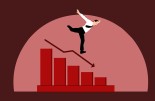Payden & Rygel: The US economy - looking forward

Commentary by Jeffrey Cleveland, Chief Economist at Payden & Rygel
The U.S. election does not change our view on the trajectory of growth or inflation
We are still solidly in the 'soft landing' camp (2-3% GDP growth, a low unemployment rate, and moderating inflation). Over the last month, we have lowered our recession probability to 15% on better income growth and unemployment.
Does Trump pose a threat to that view? The consensus chatter that Trump will be 'bad for bonds', create more inflation, etc., is up there with the most consensus views of my career. We await the actual details of any policy changes before updating our forecasts, but keep in mind: we may not have before mid or even late 2025, with policy changes that may impact the economy in 2026-2027, meaning we probably should fade knee-jerk market reactions based on few facts.
Jay Powell said: 'We don’t guess, we don’t speculate, and we don’t assume,' regarding fiscal policy changes. However, instead of shying away from taking a view, we think many of the fears are based on macro misconceptions.
The November FOMC meeting does not change our view on the trajectory of Fed policy
The Fed cut by 25 in November and will likely cut again in December. Why? With inflation moderating, there’s no reason to maintain a restrictive Fed policy. Policymakers see an above-neutral overnight rate as restrictive.
As such, the Fed is headed to 3.5% but is not in a rush. However, solid economic data does not prevent the Fed from cutting. The pace of cuts will slow in 2025 as the Fed gets closer to neutral, just as it slowed when the Fed neared its rate peak.
The macro backdrop remains favorable for risk assets
In periods when a) the Fed is cutting rates but b) the economy is NOT in a recession, risk rallies. Valuations are stretched, but credit spreads can remain narrow for extended periods (e.g., in the late 1990s and mid-2000s).
The Treasury yield back-up since mid-September may provide an excellent opportunity to extend duration
I often find myself at odds with bond market pricing; I pride myself on it. However, for the better part of three years, being at odds with the bond market meant being more 'hawkish'—expecting more rate hikes, a more extended period on 'hold' after the conclusion of the hiking cycle, and a slower pace of rate cuts once they arrived. However, the current pricing for fed funds out into 2025 is above my baseline, so, strangely, I find myself amongst the doves.
Our long-term rate framework relies on three key inputs: the Fed path, an inflation premium, and a term premium. All three components have moved up in the eyes of the market, but in each case, we think they are overestimating matters (too few cuts, too much inflation premia, too much term premium).










